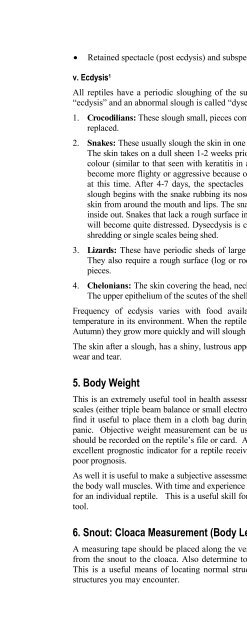Handling and Nursing Reptiles - Australian Veterinary Association
Handling and Nursing Reptiles - Australian Veterinary Association
Handling and Nursing Reptiles - Australian Veterinary Association
Create successful ePaper yourself
Turn your PDF publications into a flip-book with our unique Google optimized e-Paper software.
Retained spectacle (post ecdysis) <strong>and</strong> subspectacular abscess occur commonly.<br />
v. Ecdysis 1<br />
All reptiles have a periodic sloughing of the superficial, keratinised epithelium. This is termed<br />
“ecdysis” <strong>and</strong> an abnormal slough is called “dysecdysis”.<br />
1. Crocodilians: These slough small, pieces continually. As the old scales are worn away, they are<br />
replaced.<br />
2. Snakes: These usually slough the skin in one piece, including the spectacles covering each eye.<br />
The skin takes on a dull sheen 1-2 weeks prior to ecdysis. The spectacles become a milky blue<br />
colour (similar to that seen with keratitis in a mammal) <strong>and</strong> the snake has poor vision. Many<br />
become more flighty or aggressive because of their vision deficit. Most snakes will reuse food<br />
at this time. After 4-7 days, the spectacles clear <strong>and</strong> the slough begins 4-7 days later. The<br />
slough begins with the snake rubbing its nose <strong>and</strong> chin on a rough surface. This dislodges the<br />
skin from around the mouth <strong>and</strong> lips. The snake then crawls out of its sloughed skin, turning it<br />
inside out. Snakes that lack a rough surface in their enclosure may have difficulty shedding <strong>and</strong><br />
will become quite distressed. Dysecdysis is characterised by the skin coming off in pieces <strong>and</strong><br />
shredding or single scales being shed.<br />
3. Lizards: These have periodic sheds of large sections of the skin in pieces over several days.<br />
They also require a rough surface (log or rock) to rub against to assist in dislodging the skin<br />
pieces.<br />
4. Chelonians: The skin covering the head, neck <strong>and</strong> limbs is shed in a similar fashion to lizards.<br />
The upper epithelium of the scutes of the shell are shed 1-2 at a time <strong>and</strong> then replaced.<br />
Frequency of ecdysis varies with food availability, species, age, growth rate <strong>and</strong> ambient<br />
temperature in its environment. When the reptiles are eating regularly (Spring, Summer <strong>and</strong> early<br />
Autumn) they grow more quickly <strong>and</strong> will slough more often – as frequently as once a month.<br />
The skin after a slough, has a shiny, lustrous appearance. This becomes duller as it shows signs of<br />
wear <strong>and</strong> tear.<br />
5. Body Weight<br />
This is an extremely useful tool in health assessment. The reptile should be placed upon a set of<br />
scales (either triple beam balance or small electronic scales) <strong>and</strong> an accurate measurement taken. I<br />
find it useful to place them in a cloth bag during this procedure. This minimises struggling <strong>and</strong><br />
panic. Objective weight measurement can be used as a regular monitor to assess the reptile <strong>and</strong><br />
should be recorded on the reptile’s file or card. As an in-hospital tool, objective measurement is an<br />
excellent prognostic indicator for a reptile receiving treatment. Weight loss is always a sign of a<br />
poor prognosis.<br />
As well it is useful to make a subjective assessment of the reptile’s general condition after palpating<br />
the body wall muscles. With time <strong>and</strong> experience this can be used to determine the optimum weight<br />
for an individual reptile. This is a useful skill for clients to develop as a general health assessment<br />
tool.<br />
6. Snout: Cloaca Measurement (Body Length)<br />
A measuring tape should be placed along the ventral aspect of the snake. Determine the distance<br />
from the snout to the cloaca. Also determine to distance to any abnormal structures or masses.<br />
This is a useful means of locating normal structures <strong>and</strong> identifying amy abnormal masses or<br />
structures you may encounter.

















